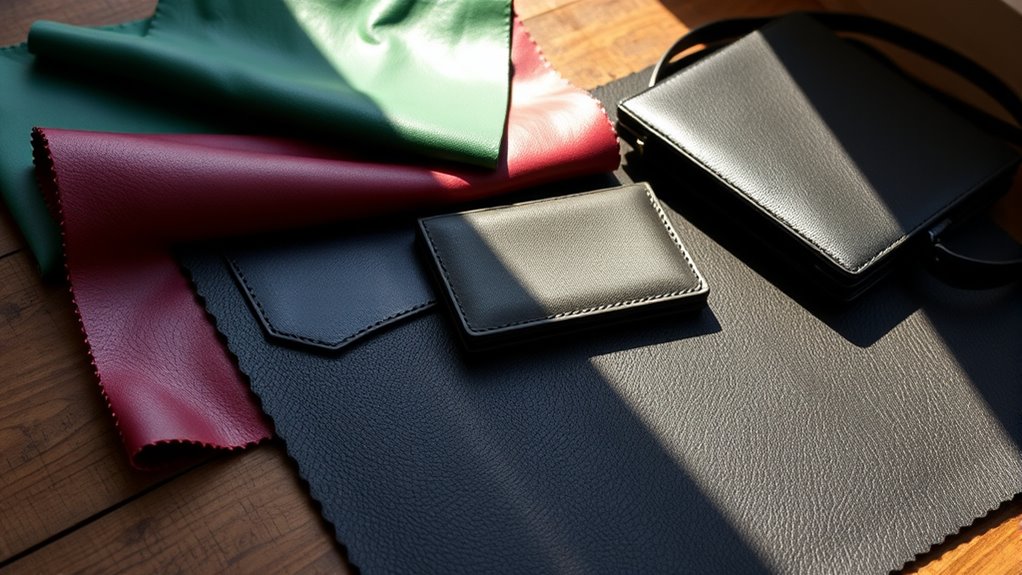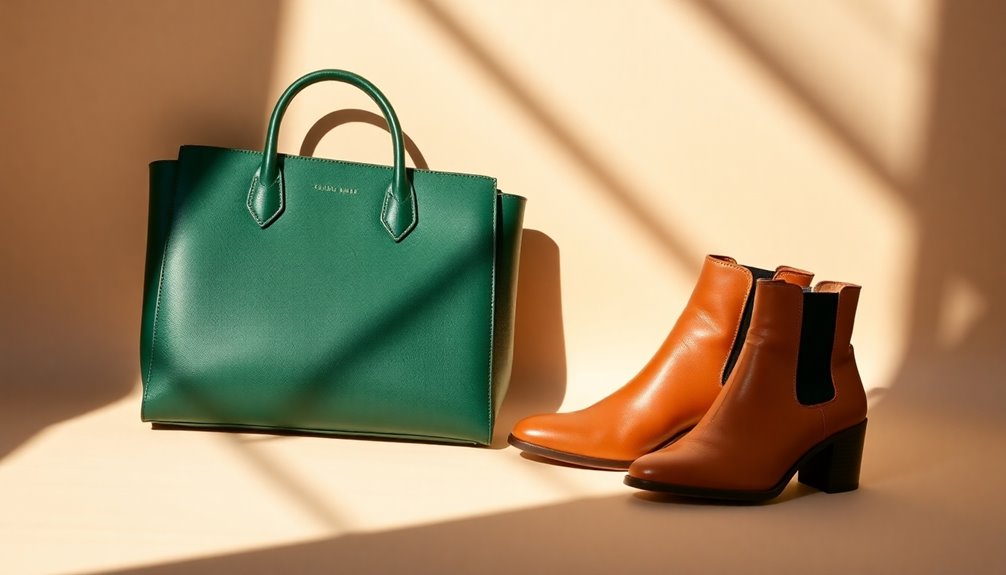Vegan leather gives you stylish, cruelty-free options that let you look great while being kind to the planet. Made from innovative materials like cork, pineapple leaves, and even mushrooms, these alternatives are more sustainable than traditional leather. Plus, they produce fewer greenhouse gases and don’t involve animal slaughter. With major brands embracing vegan leather, it’s easier than ever to choose eco-friendly fashion. Want to find out more about the exciting options available?
Key Takeaways
- Vegan leather offers stylish alternatives made from innovative materials like polyurethane, cork, and plant-based sources.
- Options like Piñatex and mushroom leather provide unique textures and designs for modern fashion.
- Major brands like Stella McCartney and H&M are embracing vegan leather, appealing to eco-conscious consumers.
- This cruelty-free material eliminates ethical concerns associated with animal products while supporting sustainability.
- Vegan leather production typically results in lower greenhouse gas emissions and reduced water pollution.

As you explore sustainable fashion, you might find that vegan leather options offer an appealing alternative to traditional materials. With growing awareness about the environmental impact of fashion, many brands are embracing vegan leather, which is often made from a range of innovative materials. One popular choice is polyurethane (PU), an eco-friendlier alternative to polyvinyl chloride (PVC), the latter often criticized for its environmental toll.
Vegan leather presents a stylish, eco-friendly alternative to traditional materials, championing sustainability in the fashion industry.
Cork leather, derived from the bark of cork oak trees, is another exciting option. It’s renewable and harvested without harming the trees, making it both sustainable and stylish. Additionally, plant-based materials like cactus, bananas, and grapes are on the rise, each providing unique textures and aesthetics. Piñatex, made from pineapple leaves, has also gained traction as a sustainable alternative, showcasing the versatility of plant-based leathers.
When it comes to sustainability, vegan leather shines in several areas. Compared to traditional animal leather, it produces fewer greenhouse gases and results in less water pollution during production. Plus, it eliminates the ethical concerns tied to animal slaughter and harmful tanning processes. Many vegan leather options, particularly those made from cork or other plant materials, are more biodegradable than synthetic alternatives, promoting a healthier environment.
By utilizing renewable resources, these materials help reduce the depletion of natural resources, making them an appealing choice for eco-conscious consumers. You’ll encounter various types of eco-friendly vegan leather as you shop, including mushroom leather, which is made from mycelium and offers a unique texture. Leaf leather, sourced from plant leaves, provides another sustainable option, while grain-based leather explores the potential of grains as raw materials.
Major brands like Stella McCartney, H&M, and Zara are increasingly incorporating vegan leather into their collections, catering to those who seek cruelty-free fashion. The production process of vegan leather is generally more environmentally friendly. It requires less water than traditional leather production and emits fewer greenhouse gases. With no animal slaughter involved, you can feel good about your choices.
Plus, the use of renewable resources and lower chemical usage further enhances its appeal. Ultimately, vegan leather options offer consumers a cruelty-free, stylish, and eco-conscious alternative. As you navigate the world of sustainable fashion, embracing these innovative materials can align your wardrobe with your values, allowing you to make a positive impact while looking great.
Frequently Asked Questions
Is Vegan Leather More Sustainable Than Traditional Leather?
When you compare vegan leather to traditional leather, it often appears more sustainable due to lower greenhouse gas emissions and reduced land use.
However, it’s essential to evaluate the materials and manufacturing processes involved.
While vegan leather can minimize animal cruelty, some synthetic options may have their own environmental drawbacks.
You’ll need to weigh these factors carefully to determine which choice aligns best with your sustainability values and lifestyle.
Can Vegan Leather Be Recycled?
Yes, vegan leather can be recycled, but it depends on the materials used.
If it’s made from natural components, like plant fibers, it might be biodegradable.
However, synthetic vegan leathers often face recycling challenges due to their composition and the lack of infrastructure.
You’ll find that some companies are exploring innovative recycling methods and upcycling options, making it essential to check the specific type of vegan leather before deciding how to dispose of it responsibly.
How Do I Care for Vegan Leather Products?
To care for your vegan leather products, use dedicated cleaners and microfiber cloths to avoid scratches.
Keep them away from excessive moisture and humidity, storing them in a cool, dry place.
When cleaning, opt for gentle detergents and spot test first.
Use vegan-specific conditioners for maintenance, applying them with terry applicators.
Always clean items before storage, and avoid overcrowding to prevent damage or color transfer.
Regular care keeps them looking great!
Does Vegan Leather Last as Long as Real Leather?
When you compare vegan leather to real leather, you’ll find that they differ considerably in durability.
Real leather can last decades with proper care, while vegan leather often doesn’t hold up as long, particularly those made from PU or PVC.
Although high-quality vegan leathers are improving, they still might degrade faster.
If you want something durable, you may prefer real leather, but consider your values and lifestyle when making your choice.
Are There Any Health Concerns Related to Vegan Leather?
Yes, there are health concerns related to vegan leather.
Many synthetic options contain toxic chemicals like phthalates and heavy metals, which can pose risks to both workers during production and consumers through skin contact or inhalation.
Additionally, the production process may release harmful emissions, contributing to air and water pollution.
It’s essential to research the materials used in vegan leather to make informed choices and minimize potential health risks.
Conclusion
In a world where style often clashes with ethics, vegan leather emerges as a perfect compromise. You can embrace fashion without the guilt of harming animals, proving that chic doesn’t have to mean cruel. Whether you’re strutting in a sleek jacket or flaunting a trendy bag, vegan leather offers vibrant alternatives that stand out. So, why choose between compassion and style when you can have both? With these cruelty-free options, you’ll look good and feel even better.










